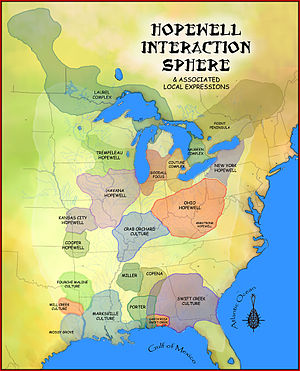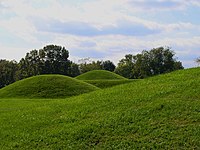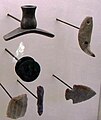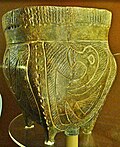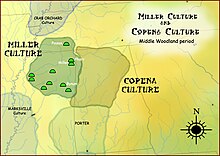Map
of the earliest securely dated sites showing human presence in the
Americas, 16–13 ka for North America and 15–11 ka for South America.
The settlement of the Americas began when Paleolithic hunter-gatherers entered North America from the North Asian Mammoth steppe via the Beringia land bridge, which had formed between northeastern Siberia and western Alaska due to the lowering of sea level during the Last Glacial Maximum.
These populations expanded south of the Laurentide Ice Sheet and spread rapidly throughout both North and South America, by 14,000 years ago. The earliest populations in the Americas, before roughly 10,000 years ago, are known as Paleo-Indians.
The peopling of the Americas is a long-standing open question, and while advances in archaeology, Pleistocene geology, physical anthropology, and DNA analysis have shed progressively more light on the subject, significant questions remain unresolved.
While there is general agreement that the Americas were first settled
from Asia, the pattern of migration, its timing, and the place(s) of
origin in Eurasia of the peoples who migrated to the Americas remain
unclear.
The prevalent migration models outline different time frames for the Asian migration from the Bering Straits and subsequent dispersal of the founding population throughout the continent. Indigenous peoples of the Americas have been linked to Siberian populations by linguistic factors, the distribution of blood types, and in genetic composition as reflected by molecular data, such as DNA.
The "Clovis first theory" refers to the 1950s hypothesis that the Clovis culture
represents the earliest human presence in the Americas, beginning about
13,000 years ago; evidence of pre-Clovis cultures has accumulated since
2000, pushing back the possible date of the first peopling of the
Americas to about 13,200–15,500 years ago.
The environment during the latest glaciation
Emergence and submergence of Beringia
Figure1. Submergence of the Beringian land bridge with post-Last Glacial Maximum (LGM) rise in eustatic sea level
During the Wisconsin glaciation, the Earth's ocean water was, to varying degrees over time, stored in glacier ice. As water accumulated in glaciers, the volume of water in the oceans correspondingly decreased, resulting in lowering of global sea level. The variation of sea level over time has been reconstructed using oxygen isotope
analysis of deep sea cores, the dating of marine terraces, and high
resolution oxygen isotope sampling from ocean basins and modern ice
caps. A drop of eustatic sea level by about 60 to 120 metres (200 to 390 ft) lower than present-day levels, commencing around 30,000 years BP, created Beringia, a durable and extensive geographic feature connecting Siberia with Alaska. With the rise of sea level after the Last Glacial Maximum
(LGM), the Beringian land bridge was again submerged. Estimates of the
final re-submergence of the Beringian land bridge based purely on
present bathymetry
of the Bering Strait and eustatic sea level curve place the event
around 11,000 years BP (Figure 1). Ongoing research reconstructing
Beringian paleogeography during deglaciation could change that estimate
and possible earlier submergence could further constrain models of human
migration into North America.
Glaciers
The
onset of the Last Glacial Maximum after 30,000 years BP saw the
expansion of alpine glaciers and continental ice sheets that blocked
migration routes out of Beringia. By 21,000 years BP, and possibly
thousands of years earlier, the Cordilleran and Laurentide ice sheets coalesced east of the Rocky Mountains, closing off a potential migration route into the center of North America. Alpine glaciers in the coastal ranges and the Alaskan Peninsula isolated the interior of Beringia from the Pacific coast. Coastal alpine glaciers and lobes of Cordilleran ice coalesced into piedmont glaciers that covered large stretches of the coastline as far south as Vancouver Island and formed an ice lobe across the Straits of Juan de Fuca by 15,000 14C years BP (18,000 cal years BP). Coastal alpine glaciers started to retreat around 19,000 cal years BP while Cordilleran ice continued advancing in the Puget lowlands up to 14,000 14C years BP (16,800 cal years BP) Even during the maximum extent of coastal ice, unglaciated refugia persisted on present-day islands, that supported terrestrial and marine mammals. As deglaciation occurred, refugia expanded until the coast became ice-free by 15,000 cal years BP.
The retreat of glaciers on the Alaskan Peninsula provided access from
Beringia to the Pacific coast by around 17,000 cal years BP. The ice barrier between interior Alaska and the Pacific coast broke up starting around 13,500 14C years (16,200 cal years) BP. The ice-free corridor to the interior of North America opened between 13,000 and 12,000 cal years BP.
Glaciation in eastern Siberia during the LGM was limited to alpine and
valley glaciers in mountain ranges and did not block access between
Siberia and Beringia.
Climate and biological environments
The
paleoclimates and vegetation of eastern Siberia and Alaska during the
Wisconsin glaciation have been deduced from high resolution oxygen
isotope data and pollen stratigraphy.
Prior to the Last Glacial Maximum, climates in eastern Siberia
fluctuated between conditions approximating present day conditions and
colder periods. The pre-LGM warm cycles in Arctic Siberia saw flourishes
of megafaunas.
The oxygen isotope record from the Greenland Ice Cap suggests that
these cycles after about 45k years BP lasted anywhere from hundreds to
between one and two thousand years, with greater duration of cold
periods starting around 32k cal years BP. The pollen record from Elikchan Lake, north of the Sea of Okhotsk, shows a marked shift from tree and shrub pollen to herb pollen prior to 26k 14C years BP, as herb tundra replaced boreal forest and shrub steppe going into the LGM.
A similar record of tree/shrub pollen being replaced with herb pollen
as the LGM approached was recovered near the Kolyma River in Arctic
Siberia.
The abandonment of the northern regions of Siberia due to rapid cooling
or the retreat of game species with the onset of the LGM has been
proposed to explain the lack of archaeosites in that region dating to
the LGM.
The pollen record from the Alaskan side shows shifts between herb/shrub
and shrub tundra prior to the LGM, suggesting less dramatic warming
episodes than those that allowed forest colonization on the Siberian
side. Diverse, though not necessarily plentiful, megafaunas were present in those environments. Herb tundra dominated during the LGM, due to cold and dry conditions.
Coastal environments during the Last Glacial Maximum were complex. The lowered sea level, and an isostatic
bulge equilibrated with the depression beneath the Cordilleran Ice
Sheet, exposed the continental shelf to form a coastal plain. While much of the coastal plain was covered with piedmont glaciers, unglaciated refugia supporting terrestrial mammals have been identified on Haida Gwaii, Prince of Wales Island, and outer islands of the Alexander Archipelago. The now-submerged coastal plain has potential for more refugia.
Pollen data indicate mostly herb/shrub tundra vegetation in unglaciated
areas, with some boreal forest towards the southern end of the range of
Cordilleran ice. The coastal marine environment remained productive, as indicated by fossils of pinnipeds. The highly productive kelp forests over rocky marine shallows may have been a lure for coastal migration. Reconstruction of the southern Beringian coastline also suggests potential for a highly productive coastal marine environment.
Environmental changes during deglaciation
Pollen data indicate a warm period culminating between 14k and 11k 14C years BP (17k-13k cal years BP) followed by cooling between 11k-10k 14C years BP (13k-11.5k cal years BP).[23]
Coastal areas deglaciated rapidly as coastal alpine glaciers, then
lobes of Cordilleran ice, retreated. The retreat was accelerated as sea
levels rose and floated glacial termini. Estimates of a fully ice-free
coast range between 16k and 15k cal years BP. Littoral
marine organisms colonized shorelines as ocean water replaced glacial
meltwater. Replacement of herb/shrub tundra by coniferous forests was
underway by 12.4k 14C years BP (15k cal years BP) north of
Haida Gwaii. Eustatic sea level rise caused flooding, which accelerated
as the rate grew more rapid.
The inland Cordilleran and Laurentide ice sheets retreated more
slowly than did the coastal glaciers. Opening of an ice-free corridor
did not occur until after 13k to 12k cal years BP.
The early environment of the ice-free corridor was dominated by glacial
outwash and meltwater, with ice-dammed lakes and periodic flooding from
the release of ice-dammed meltwater. Biological productivity of the deglaciated landscape was gained slowly. The earliest possible viability of the ice-free corridor as a human migration route has been estimated at 11.5k cal years BP.
Birch forests were advancing across former herb tundra in Beringia by 14.3ka 14C years BP (17k cal years BP) in response to climatic amelioration, indicating increased productivity of the landscape.
Chronology, reasons for, and sources of migration
25,000 years ago Beringia during the LGM 16-14,000 years ago peopling of the Americas just after the LGM
The archaeological community is in general agreement that the ancestors of the Indigenous peoples of the Americas of historical record entered the Americas at the end of the Last Glacial Maximum (LGM), shortly after 20,000 years ago, with ascertained archaeological presence shortly after 16,000 years ago.
There remain uncertainties regarding the precise dating of individual sites and regarding conclusions drawn from population genetics
studies of contemporary Native Americans. It is also an open question
whether this post-LGM migration represented the first peopling of the
Americas, or whether there had been an earlier, pre-LGM migration which
had reached South America as early as 40,000 years ago.
Chronology
In the early 21st century, the models of the chronology of migration are divided into two general approaches.
The first is the short chronology theory, that the first migration occurred after the Last Glacial Maximum, which went into decline after about 19,000 years ago, and was then followed by successive waves of immigrants.
The second theory is the long chronology theory, which proposes that the first group of people entered the Americas at a much earlier date, possibly before 40,000 years ago, followed by a much later second wave of immigrants.
The Clovis First theory,
which dominated thinking on New World anthropology for much of the 20th
century, was challenged by the secure dating of archaeosites in the
Americas to before 13,000 years ago in the 2000s.
The "short chronology" scenario, in the light of this, refers to a
peopling of the Americas shortly after 19,000 years ago, while the "long
chronology" scenario permits pre-LGM presence, by around 40,000 years
ago.
The archaeosites in the Americas with the oldest dates that have
gained broad acceptance are all compatible with an age of about 15,000
years. This includes the Buttermilk Creek Complex in Texas, the Meadowcroft Rockshelter site in Pennsylvania and the Monte Verde site in southern Chile. Archaeological evidence of pre-Clovis people points to the South Carolina Topper Site being 16,000 years old, at a time when the glacial maximum would have theoretically allowed for lower coastlines.
It has often been suggested that an ice-free corridor, in what is now Western Canada, would have allowed migration before the beginning of the Holocene,
but a 2016 study has argued against this, suggesting that the peopling
of North America via such a corridor is unlikely to significantly
pre-date the earliest Clovis sites. The study concludes that the
ice-free corridor in what is now Alberta and British Columbia
"was gradually taken over by a boreal forest dominated by spruce and
pine trees" and that the "Clovis people likely came from the south, not
the north, perhaps following wild animals such as bison".
An alternative hypothesis for the peopling of America is coastal migration,
which may have been feasible along the deglaciated (but now submerged)
coastline of the Pacific Northwest from about 16,000 years ago.
Evidence for pre-LGM human presence
Figure 2. Schematic illustration of maternal (mtDNA) gene-flow in and out of Beringia (long chronology, single source model).
Map
of Beringia showing the exposed seafloor and glaciation at 40,000 years
ago and 16,000 years ago. The green arrow indicates the "interior
migration" model along an ice-free corridor separating the major
continental ice sheets, the red arrow indicates the "coastal migration" model, both leading to a "rapid colonization" of the Americas after c. 16,000 years ago.
Pre-Last Glacial Maximum migration across Beringia into the Americas
has been proposed to explain purported pre-LGM ages of archaeosites in
the Americas such as Bluefish Caves and Old Crow Flats in the Yukon Territory, and Meadowcroft Rock Shelter in Pennsylvania.
At the Old Crow Flats, mammoth bones have been found that are
broken in distinctive ways indicating human butchery. The radiocarbon
dates on these vary between 25,000 and 40,000 years BP. Also, stone
microflakes have been found in the area indicating tool production.
Previously, the interpretations of butcher marks and the geologic
association of bones at the Bluefish Cave and Old Crow Flats sites, and
the related Bonnet Plume site, have been called into question.
Pre-LGM human presence in South America rests partly on the chronology of the controversial Pedra Furada rock shelter in Piauí, Brazil. A 2003 study dated evidence for the controlled use of fire to before 40,000 years ago. Additional evidence has been adduced from the morphology of Luzia Woman fossil, which was described as Australoid.
This interpretation was challenged in a 2003 review which concluded the
features in question could also have arisen by genetic drift.
The ages of the earliest positively identified artifacts at the
Meadowcroft site are safely within the post-LGM period (13.8k–18.5k cal years BP).
Stones described as probable tools, hammerstones and anvils, have been found in southern California, at the Cerutti Mastodon site, that are associated with a mastodon
skeleton which appeared to have been processed by humans. The mastodon
skeleton was dated by thorium-230/uranium radiometric analysis, using
diffusion–adsorption–decay dating models, to 130.7 ± 9.4 thousand years
ago.[44] No human bones were found, and the claims of tools and bone processing have been described as "not plausible".
The Yana River Rhino Horn site (RHS) has dated human occupation of eastern Arctic Siberia to 27k 14C years BP (31.3k cal years BP).
That date has been interpreted by some as evidence that migration into
Beringia was imminent, lending credence to occupation of Beringia during
the LGM. However, the Yana RHS date is from the beginning of the cooling period that led into the LGM.
But, a compilation of archaeosite dates throughout eastern Siberia
suggest that the cooling period caused a retreat of humans southwards.
Pre-LGM lithic evidence in Siberia indicate a settled lifestyle that
was based on local resources, while post-LGM lithic evidence indicate a
more migratory lifestyle.
The oldest archaeosite on the Alaskan side of Beringia date to 12k 14C years BP (14k cal years BP).
It is possible that a small founder population had entered Beringia
before that time. However, archaeosites that date closer to the Last
Glacial Maximum on either the Siberian or the Alaskan side of Beringia
are lacking.
Genomic age estimates
Studies of Amerindian genetics
have used high resolution analytical techniques applied to DNA samples
from modern Native Americans and Asian populations regarded as their
source populations to reconstruct the development of human Y-chromosome DNA haplogroups (yDNA haplogroups) and human mitochondrial DNA haplogroups (mtDNA haplogroups) characteristic of Native American populations.
Models of molecular evolution rates were used to estimate the ages at
which Native American DNA lineages branched off from their parent
lineages in Asia and to deduce the ages of demographic events. One model
(Tammetal 2007) based on Native American mtDNA Haplotypes (Figure 2)
proposes that migration into Beringia
occurred between 30k and 25k cal years BP, with migration into the
Americas occurring around 10k to 15k years after isolation of the small founding population.
Another model (Kitchen et al. 2008) proposes that migration into
Beringia occurred approximately 36k cal years BP, followed by 20k years
of isolation in Beringia.
A third model (Nomatto et al. 2009) proposes that migration into
Beringia occurred between 40k and 30k cal years BP, with a pre-LGM
migration into the Americas followed by isolation of the northern
population following closure of the ice-free corridor. Evidence of Australo-Melanesians admixture in Amazonian populations was found by Skoglund and Reich (2016).
A study of the diversification of mtDNA Haplogroups C and D from
southern Siberia and eastern Asia, respectively, suggests that the
parent lineage (Subhaplogroup D4h) of Subhaplogroup D4h3, a lineage
found among Native Americans and Han Chinese, emerged around 20k cal years BP, constraining the emergence of D4h3 to post-LGM. Age estimates based on Y-chromosome micro-satellite diversity place origin of the American Haplogroup Q1a3a (Y-DNA) at around 10k to 15k cal years BP.
Greater consistency of DNA molecular evolution rate models with each
other and with archaeological data may be gained by the use of dated
fossil DNA to calibrate molecular evolution rates.
Source populations
There
is general agreement among anthropologists that the source populations
for the migration into the Americas originated from an area somewhere
east of the Yenisei River (Russian Far East).
The common occurrence of the mtDNA Haplogroups A, B, C, and D among
eastern Asian and Native American populations has long been recognized,
along with the presence of haplogroup X. As a whole, the greatest frequency of the four Native American associated haplogroups occurs in the Altai-Baikal region of southern Siberia. Some subclades of C and D closer to the Native American subclades occur among Mongolian, Amur, Japanese, Korean, and Ainu populations.
A 2019 study suggested that Native Americans are the closest living relatives to 10,000-year-old fossils found near the Kolyma River in northeastern Siberia.
Human genomic models
The development of high-resolution genomic analysis has provided
opportunities to further define Native American subclades and narrow the
range of Asian subclades that may be parent or sister subclades. For
example, the broad geographic range of haplogroup X has been interpreted
as allowing the possibility of a western Eurasian, or even a European
source population for Native Americans, as in the Solutrean hypothesis, or suggesting a pre-Last Glacial Maximum migration into the Americas.
The analysis of an ancient variant of haplogroup X among aboriginals of
the Altai region indicates common ancestry with the European strain
rather than descent from the European strain.
Further division of X subclades has allowed identification of
subhaplogroup X2a, which is regarded as specific to Native Americans.
With further definition of subclades related to Native American
populations, the requirements for sampling Asian populations to find the
most closely related subclades grow more specific. Subhaplogroups D1
and D4h3 have been regarded as Native American specific based on their
absence among a large sampling of populations regarded as potential
descendants of source populations, over a wide area of Asia. Among the 3764 samples, the Sakhalin – lower Amur region was represented by 61 Oroks. In another study, Subhaplogroup D1a has been identified among the Ulchis of the lower Amur River region (4 among 87 sampled, or 4.6%), along with Subhaplogroup C1a (1 among 87, or 1.1%). Subhaplogroup C1a is regarded as a close sister clade of the Native American Subhaplogroup C1b.
Subhaplogroup D1a has also been found among ancient Jōmon skeletons from Hokkaido The modern Ainu are regarded as descendants of the Jōmon.
The occurrence of the Subhaplogroups D1a and C1a in the lower Amur
region suggests a source population from that region distinct from the
Altai-Baikal source populations, where sampling did not reveal those two
particular subclades. The conclusions regarding Subhaplogroup D1 indicating potential source populations in the lower Amur and Hokkaido areas stand in contrast to the single-source migration model.
Subhaplogroup D4h3 has been identified among Han Chinese.
Subhaplogroup D4h3 from China does not have the same geographic
implication as Subhaplotype D1a from Amur-Hokkaido, so its implications
for source models are more speculative. Its parent lineage, Subhaplotype
D4h, is believed to have emerged in east Asia, rather than Siberia,
around 20k cal years BP. Subhaplogroup D4h2, a sister clade of D4h3, has also been found among Jōmon skeletons from Hokkaido. D4h3 has a coastal trace in the Americas.
The contrast between the genetic profiles of the Hokkaido Jōmon
skeletons and the modern Ainu illustrates another uncertainty in source
models derived from modern DNA samples:
However, probably due to the small sample size or close consanguinity among the members of the site, the frequencies of the haplogroups in Funadomari skeletons were quite different from any modern populations, including Hokkaido Ainu, who have been regarded as the direct descendant of the Hokkaido Jōmon people.
The descendants of source populations with the closest relationship
to the genetic profile from the time when differentiation occurred are
not obvious. Source population models can be expected to become more
robust as more results are compiled, the heritage of modern proxy
candidates becomes better understood, and fossil DNA in the regions of
interest is found and considered.
HTLV-1 genomics
The Human T cell Lymphotrophic Virus 1 (HTLV-1)
is a virus transmitted through exchange of bodily fluids and from
mother to child through breast milk. The mother-to-child transmission
mimics a hereditary trait, although such transmission from maternal
carriers is less than 100%.
The HTLV virus genome has been mapped, allowing identification of four
major strains and analysis of their antiquity through mutations. The
highest geographic concentrations of the strain HLTV-1 are in
sub-Saharan Africa and Japan. In Japan, it occurs in its highest concentration on Kyushu. It is also present among African descendants and native populations in the Caribbean region and South America. It is rare in Central America and North America. Its distribution in the Americas has been regarded as due to importation with the slave trade.
The Ainu have developed antibodies to HTLV-1, indicating its endemicity to the Ainu and its antiquity in Japan.
A subtype "A" has been defined and identified among the Japanese
(including Ainu), and among Caribbean and South American isolates. A subtype "B" has been identified in Japan and India. In 1995, Native Americans in coastal British Columbia were found to have both subtypes A and B. Bone marrow specimens from an Andean mummy about 1500 years old were reported to have shown the presence of the A subtype.
The finding ignited controversy, with contention that the sample DNA
was insufficiently complete for the conclusion and that the result
reflected modern contamination.
However, a re-analysis indicated that the DNA sequences were consistent
with, but not definitely from, the "cosmopolitan clade" (subtype A).
The presence of subtypes A and B in the Americas is suggestive of a
Native American source population related to the Ainu ancestors, the
Jōmon.
Physical anthropology
Paleoamerican skeletons in the Americas such as Kennewick Man (Washington State), Hoya Negro skeleton (Yucatán), Luzia Woman and other skulls from the Lagoa Santa site (Brazil), Buhl Woman (Idaho), Peñon Woman III, two skulls from the Tlapacoya site (Mexico City), and 33 skulls from Baja California
have exhibited craniofacial traits distinct from most modern Native
Americans, leading physical anthropologists to the opinion that some
Paleoamericans were of an Australoid rather than Siberian origin. The most basic measured distinguishing trait is the dolichocephaly of the skull. Some modern isolates such as the Pericúes of Baja California and the Fuegians of Tierra del Fuego exhibit that same morphological trait. Other anthropologists advocate an alternative hypothesis that evolution of an original Beringian phenotype
gave rise to a distinct morphology that was similar in all known
Paleoamerican skulls, followed by later convergence towards the modern
Native American phenotype.
Resolution of the issue awaits the identification of a Beringian
phenotype among paleoamerican skulls or evidence of a genetic clustering
among examples of the Australoid phenotype.
A report published in the American Journal of Physical Anthropology
in January 2015 reviewed craniofacial variation focussing on
differences between early and late Native Americans and explanations for
these based on either skull morphology or molecular genetics. Arguments
based on molecular genetics have in the main, according to the authors,
accepted a single migration from Asia with a probable pause in
Berengia, plus later bi-directional gene flow. Studies focussing on
craniofacial morphology have argued that Paleoamerican remains have
"been described as much closer to African and Australo-Melanesians
populations than to the modern series of Native Americans", suggesting
two entries into the Americas, an early one occurring before a
distinctive East Asian morphology developed (referred to in the paper as
the "Two Components Model". A third model, the "Recurrent Gene Flow"
[RGF] model, attempts to reconcile the two, arguing that circumarctic
gene flow after the initial migration could account for morphological
changes. It specifically re-evaluates the original report on the Hoya
Negro skeleton which supported the RGF model, the authors disagreed with
the original conclusion which suggested that the skull shape did not
match those of modern Native Americans, arguing that the "skull falls
into a subregion of the morphospace occupied by both Paleoamericans and
some modern Native Americans."
Stemmed points
Stemmed
points are a lithic technology distinct from Beringian and Clovis
types. They have a distribution ranging from coastal east Asia to the
Pacific coast of South America. The emergence of stemmed points has been traced to Korea during the upper Paleolithic.
The origin and distribution of stemmed points have been interpreted as a
cultural marker related to a source population from coastal east Asia.
Migration routes
Interior route
Map showing the approximate location of the ice-free corridor along the Continental Divide, separating the Cordilleran and Laurentide ice sheets. Also indicated are the locations of the Clovis and Folsom Paleo-Indian sites.
Historically, theories about migration into the Americas have
centered on migration from Beringia through the interior of North
America. The discovery of artifacts in association with Pleistocene
faunal remains near Clovis, New Mexico
in the early 1930s required extension of the timeframe for the
settlement of North America to the period during which glaciers were
still extensive. That led to the hypothesis of a migration route between
the Laurentide and Cordilleran ice sheets to explain the early
settlement. The Clovis site was host to a lithic technology
characterized by spear points with an indentation, or flute, where the
point was attached to the shaft. A lithic complex characterized by the Clovis Point
technology was subsequently identified over much of North America and
in South America. The association of Clovis complex technology with late
Pleistocene faunal remains led to the theory that it marked the arrival
of big game hunters that migrated out of Beringia then dispersed
throughout the Americas, otherwise known as the Clovis First theory.
Recent radiocarbon dating of Clovis sites has yielded ages of 11.1k to 10.7k 14C years BP (13k to 12.6k cal years BP), somewhat later than dates derived from older techniques.
The re-evaluation of earlier radiocarbon dates led to the conclusion
that no fewer than 11 of the 22 Clovis sites with radiocarbon dates are
"problematic" and should be disregarded, including the type site
in Clovis, New Mexico. Numerical dating of Clovis sites has allowed
comparison of Clovis dates with dates of other archaeosites throughout
the Americas, and of the opening of the ice-free corridor. Both lead to
significant challenges to the Clovis First theory. The Monte Verde site
of Southern Chile has been dated at 14.8k cal years BP. The Paisley Cave site in eastern Oregon yielded a 14C date of 12.4k years (14.5k cal years) BP, on a coprolite with human DNA and 14C dates of 11.3k-11k (13.2k-12.9k cal years) BP on horizons containing western stemmed points.
Artifact horizons with non-Clovis lithic assemblages and pre-Clovis
ages occur in eastern North America, although the maximum ages tend to
be poorly constrained.
Geological findings on the timing of the ice-free corridor also
challenge the notion that Clovis and pre-Clovis human occupation of the
Americas was a result of migration through that route following the Last Glacial Maximum.
Pre-LGM closing of the corridor may approach 30k cal years BP and
estimates of ice retreat from the corridor are in the range of 12 to 13k
cal years BP.
Viability of the corridor as a human migration route has been estimated
at 11.5k cal years BP, later than the ages of the Clovis and pre-Clovis
sites. Dated Clovis archaeosites suggest a south-to-north spread of the Clovis culture.
Pre-Last Glacial Maximum migration into the interior has been
proposed to explain pre-Clovis ages for archaeosites in the Americas, although pre-Clovis sites such as Meadowcroft Rock Shelter, Monte Verde, and Paisley Cave have not yielded confirmed pre-LGM ages.
Dené–Yeniseian language family proposal
A relationship between the Na-Dené languages of North America (such as Navajo and Apache), and the Yeniseian languages of Siberia was first proposed as early as 1923, and developed further by others. A detailed study was done by Edward Vajda and published in 2010. This theory received support from many linguists. Also archaeological and genetic studies gave it further support.
The Arctic Small Tool tradition
of Alaska and the Canadian Arctic may have originated in East Siberia
about 5,000 years ago. This is connected with the ancient Paleo-Eskimo peoples of the Arctic, the culture that developed by 2500 BCE.
The Arctic Small Tool tradition source may have been the Syalakh-Bel’kachi-Ymyakhtakh culture sequence of East Siberia, dated to 6,500 – 2,800 calBP.
The interior route is consistent with the spread of the Na-Dene language group and subhaplogroup X2a into the Americas after the earliest paleoamerican migration.
Nevertheless, some scholars suggest that the ancestors of western
North Americans speaking Na-Dene languages made a coastal migration by
boat.
Pacific coastal route
The Pacific 'coastal migration theory' proposes that people first
reached the Americas via water travel, following coastlines from
northeast Asia into the Americas, originally proposed in 1979 by Knute
Fladmark as an alternative to the ice-free corridor hypothesis.
This model would help to explain the rapid spread to coastal
sites extremely distant from the Bering Strait region, including sites
such as Monte Verde in southern Chile and Taima-Taima in western Venezuela.
The "marine migration hypothesis" is a variant of coastal migration
which postulates the use of boats. The proposed use of boats adds a
measure of flexibility to the chronology of coastal migration, because a
continuous ice-free coast (16k-15k cal years BP) would no longer be
required as migrants
would have settled in coastal refugia during deglaciation of the coast. A
coastal east Asian source population is integral to the marine
migration hypothesis.
A 2007 article in the Journal of Island and Coastal Archaeology proposed a "kelp highway hypothesis", a variant of coastal migration based on the exploitation of kelp
forests along much of the Pacific Rim from Japan to Beringia, the
Pacific Northwest, and California, and as far as the Andean Coast of
South America. Once the coastlines of Alaska and British Columbia had
deglaciated about 16,000 years ago, these kelp forest (along with
estuarine, mangrove, and coral reef) habitats would have provided an
ecologically homogenous migration corridor, entirely at sea level, and
essentially unobstructed.
A 2016 DNA analysis of plants and animals suggest a coastal route was
feasible.
Mitochondrial subhaplogroup D4h3a, a rare subclade of D4h3 occurring along the west coast of the Americas, has been identified as a clade associated with coastal migration.
This haplogroup was found in a skeleton referred to as Anzick-1, found in Montana in close association with several Clovis artifacts, dated 12,500 years ago.
Problems with evaluating coastal migration models
The
coastal migration models provide a different perspective on migration
to the New World, but they are not without their own problems. One such
problem is that global sea levels have risen over 120 metres (390 ft)
since the end of the last glacial period, and this has submerged the
ancient coastlines that maritime people would have followed into the
Americas. Finding sites associated with early coastal migrations is
extremely difficult—and systematic excavation of any sites found in
deeper waters is challenging and expensive. Strategies for finding
earliest migration sites include identifying potential sites on
submerged paleoshorelines, seeking sites in areas uplifted either by
tectonics or isostatic rebound, and looking for riverine sites in areas
that may have attracted coastal migrants. On the other hand, there is evidence of marine technologies found in the hills of the Channel Islands of California, circa 10,000 BCE.
If there was an early pre-Clovis coastal migration, there is always the
possibility of a "failed colonization". Another problem that arises is
the lack of hard evidence found for a "long chronology" theory. No sites
have yet produced a consistent chronology older than about 12,500
radiocarbon years (~14,500 calendar years), but research has been limited in South America related to the possibility of early coastal migrations.
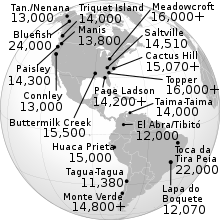
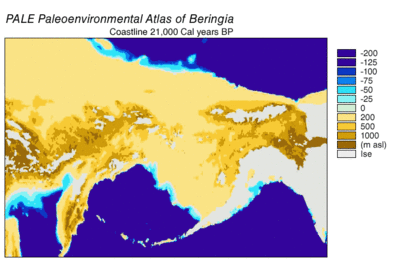
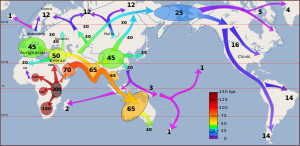

!["Maps depicting each phase of the three-step early human migrations for the peopling of the Americas. (A) Gradual population expansion of the Amerind ancestors from their Central East Asian gene pool (blue arrow). (B) Proto-Amerind occupation of Beringia with little to no population growth for ≈20,000 years. (C) Rapid colonization of the New World by a founder group migrating southward through the ice-free, inland corridor between the eastern Laurentide and western Cordilleran Ice Sheets (green arrow) and/or along the Pacific coast (red arrow). In (B), the exposed seafloor is shown at its greatest extent during the last glacial maximum at ≈20–18,000 years ago [25]. In (A) and (C), the exposed seafloor is depicted at ≈40,000 years ago and ≈16,0000 years ago, when prehistoric sea levels were comparable. A scaled-down version of Beringia today (60% reduction of A–C) is presented in the lower left corner. This smaller map highlights the Bering Strait that has geographically separated the New World from Asia since ≈11–10,000 years ago."](https://upload.wikimedia.org/wikipedia/commons/thumb/d/d7/Journal.pone.0001596.g004.png/280px-Journal.pone.0001596.g004.png)

